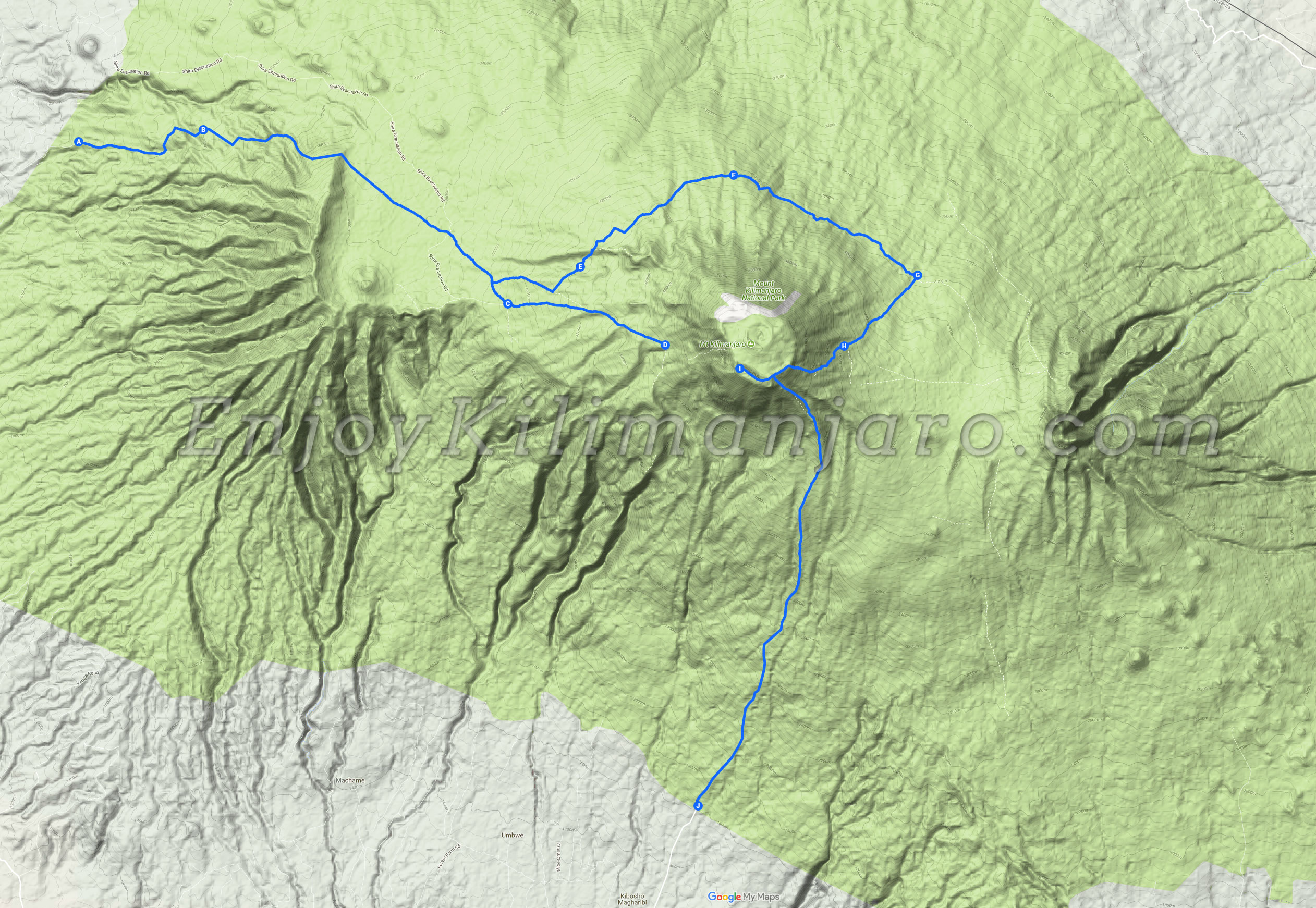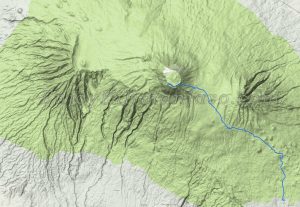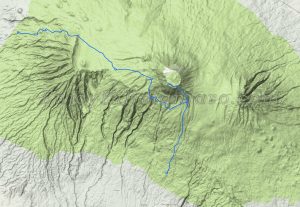Description
Please see the tabs above for more detailed information, such as itineraries, what’s included, and what you should bring.
If you are interested in booking this trip, start by contacting us. We will ensure availability of guides, porters, and park openings.
Once everything is approved, we can accept payment via credit card (using PayPal).
Northern Circuit Itinerary
Day 1 – Londorossi Gate (2,100 meters) – start point 2,360 meters to Mti Mkubwa Camp (2,820 meters)
- Distance: ~5.5km / 3 miles
- Trekking time: 3-4 hours
- Zone: Rainforest
The Northern Circuit Route begins at Londorossi Gate (2,100 meters) in the West, the same start point as the Lemosho Route. The drive to Londorossi Gate takes approximately two hours from Moshi and considerably longer from Arusha. Registration with the Kilimanjaro National Park authorities occurs at the gate and then you will be driven further up the mountain to the trailhead starting point. Most tour operators serve lunch here before the short first day trek to Mti Mkubwa Camp (2,820 meters) begins. You may get lucky and spot large wildlife like elephant and buffalo that sometimes emerge from the rainforest onto the path as you trek towards your first camp. Dinner will be served when you reach Mti Mkubwa Camp.
Day 2 – Mti Mkubwa Camp (2,820 meters) to Shira Camp 1 (3,610 meters)
- Distance: ~8km / 5 miles
- Trekking time: 5-6 hours
- Zone: Rainforest / Low Alpine Zone
On day two you will spend the first hour trekking through the last section of rainforest path before entering the low alpine moorland zone which follows up onto the Shira Plateau. The trek is relatively short and gradual, ending at Shira Camp 1 (3,610 meters).
Day 3 – Shira Camp 1 (3,610 meters) to Shira Camp 2 (3,850 meters)
- Distance: ~7km / 4 miles
- Trekking time: 3-4 hours
- Zone: Rainforest / Low Alpine Zone
On day three the trek crosses the Shira Plateau from Shira Camp 1 to Shira Camp 2. Nine day trekkers usually spend the night at Shira Camp 2 where they will join trekkers from the Machame Route. At Shira Camp 2 it is worth trekking a little higher up the plateau to enjoy the stunning view across the valley below and Western Breach of Kilimanjaro above. The plateau is exposed so be prepared for a cold night with temperatures getting below zero. Note: Trekkers on an eight day hike will continue east up the Shira Plateau ridge and on to Lava Tower (4,600 meters) and then back down via the Northern Circuit to Moir Camp (4,200 meters).
Day 4 – Shira Camp 2 (3,850 meters) to Lava Tower (4,600 meters) and then north to Moir Camp (4,200 meters)
- Distance: ~14km / 8 miles
- Trekking time: 5-7 hours
- Zone: Low alpine zone / High alpine zone
Day four is a long trek heading east which passes through the ‘Garden of the Senecios’ and then enters the high alpine desert zone. The morning is spent trekking up to Lava Tower and the iconic Shark’s Tooth rock formation at 4,600 meters, where you will have lunch. After lunch you will join the northern circuit heading down to Moir Camp at 4,200 meters (see map above). This is an important day in your trek as you will get to experience high altitude and then sleep low, which is good for the acclimatisation process.
Day 5 – Moir Camp (4,200 meters) to Buffalo Camp (4,020 meters)
- Distance: ~12km / 7 miles
- Trekking time: 5-7 hours
- Zone: High alpine zone
Day five involves a moderately steep climb out of Moir Valley. Trekkers can take a small detour here to climb the summit of Little Lent Hill at 4,375 meters before returning to the Northern Circuit trail. From here the route follows a series of inclines and declines, skirting around the northern slopes of Kibo to Buffalo Camp (4,020 meters).The trek gives great vistas out across the plains that lie north of Kilimanjaro and stretch out to the Kenyan / Tanzanian border. You will arrive at Buffalo Camp just after midday, where you will have lunch and have time to rest after a long day hiking.
Day 6 – Buffalo Camp (4,020 meters) to Rongai Third Cave (3,800 meters)
- Distance: ~8km / 5 miles
- Trekking time: 5-7 hours
- Zone: High alpine zone and low alpine zone
Day six starts with a climb up the Buffalo ridge and down into Porfu Camp where lunch is usually served. The route then continues east around the northern slopes to the Rongai Third Cave at 3,800 meters. The trek is shorter than the day before and by now you should be feeling well acclimatised to the altitude. You will arrive at the Third Cave just around mid-afternoon.
Day 7 – 3rd Cave (3,800 meters) to School Hut (4,800 meters)
- Distance: ~15km / 8 miles
- Trekking time: 4-5 hours
- Zone: High alpine zone and glacial zone
Day seven involves a steady incline up and over the Saddle which sits between the peaks of Kibo and Mawenzi Peak. Trekkers then continue walking south-west up to School Hut (4,800 meters). After arriving at School Hut you will be served an early dinner and then you should get some shut-eye as you will be awoken before midnight to start your summit attempt. Remember to prepare all your gear, including warm clothes, insulated water bottles, snacks, headlamp and camera before going to bed.
Day 8 – School Hut (4,800 meters) to Uhuru Peak (5,895 meters) and then onto Millennium Camp (3,950 meters)
- Distance: ~6km / 3.5 miles ascent and 10.5km / 6 mile descent
- Trekking time: 6-8 hours ascent and then 4-6 hour descent
- Zone: Glacial zone and all preceding zones
You will be awoken around 11:30 with hot tea and biscuits and will then begin the steep incline up the slopes of Kibo under the cover of darkness. Your first check-point is Hans Meyer Cave where you will take a short break. The climb steepens as you approach Gilman’s Point (5,681 meters), which will be around 5-6 hours after departing School Hut. Take a moment to enjoy the approaching dawn and incredible view out and across to Mawenzi Peak, but remember you still have 2 hours trekking to reach Uhuru Peak so dig deep for the energy. The slope flattens as you head west around the crater rim and you should arrive at the summit at or just after sunrise. Your stay here will be brief so get as many pictures as you can of the incredible views and surrounding glaciers. You will then retrace your steps back around the carter rim to Stella Point (5,739 meters) where you will turn south and head down the heavily screed slopes of Kibo to Barafu Camp (4,680 meters). Most trekkers take a short break here before continuing down to Millennium Camp (3,950 meters) for your final night on the mountain. In total you will be trekking for 14-16 hours on day eight so it is important to pace yourself, remain hydrated and keep your blood sugar levels up. Note: some tour operators return via Gilman’s Point to Horombo Hut using the Marangu Route.
Day 9 – Millennium Camp (3,950 meters) to Mweka Gate (1,640 meters)
- Distance: ~10km / 6.5 miles
- Trekking time: 3-4 hours
- Zone: Rainforest zone
The final day is a short hike through the dense montane rainforest from Millennium Camp (3,950 meters) to Mweka Gate (1,640 meters). At the gate you will need to sign-out with the authorities, who will also provide you with your official certificate – a green certificate for those who made it to Gilman’s Point and a gold certificate for those who reached Uhuru Peak. It is customary to give your guides and porters tips at this point before being driven back to your hotel in Moshi or Arusha.
What's Included?
Included in this price, you will receive:
- Pickup / Drop off from Airport
- Accomodations in Hotel in Arusha for first night before hike, and one night after
- All associated fees, such as park fees, guide fees, rescue fees, camping fees, etc.
- Tents and other camping facilities
- 3 prepared meals, daily
- Clean water
Generally speaking, the price shown above covers everything. It does not, however, cover any additional expenses such as snacks, alcohol, or tips for the guides and porters.
What Should I Bring?
Although we provide communal items such as tents, cookware, etc., you must bring personal items with you. For a full recommended list, please check our “what to bring” page by clicking here.




